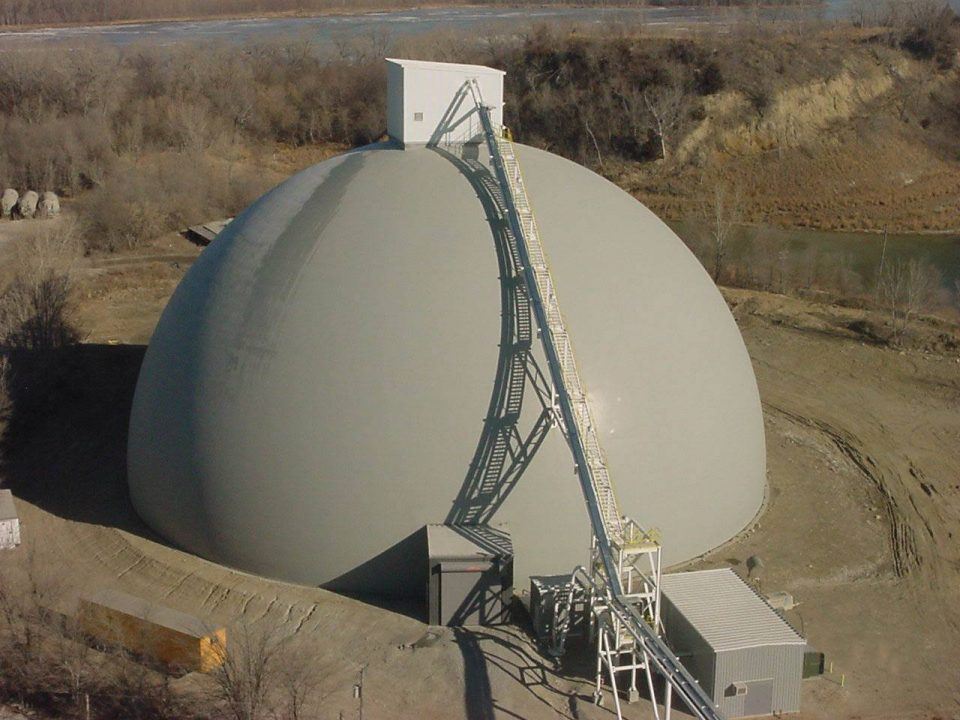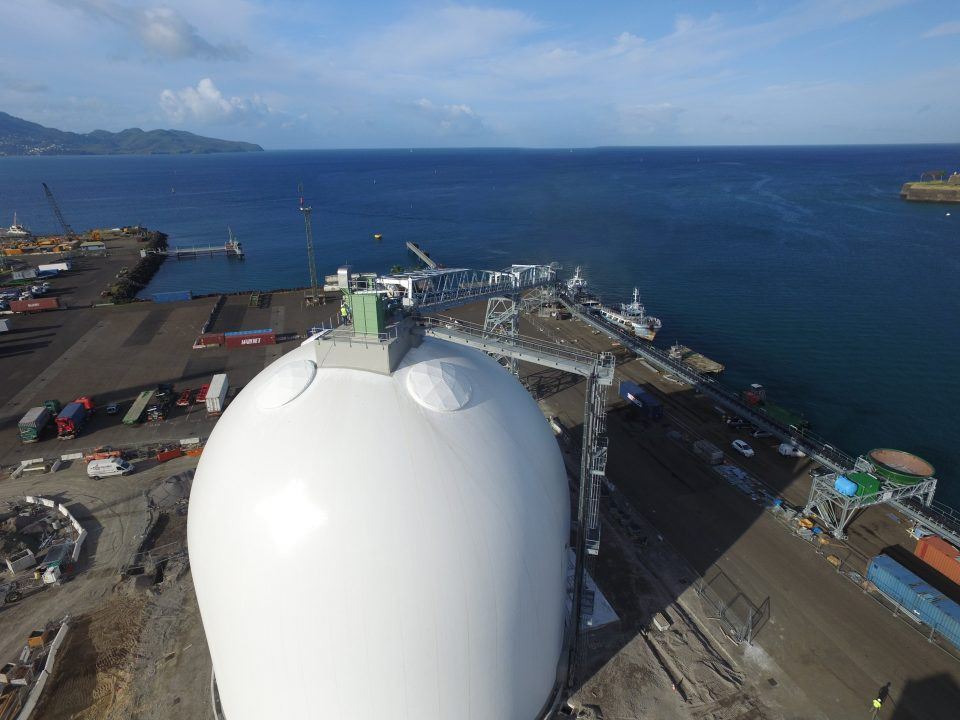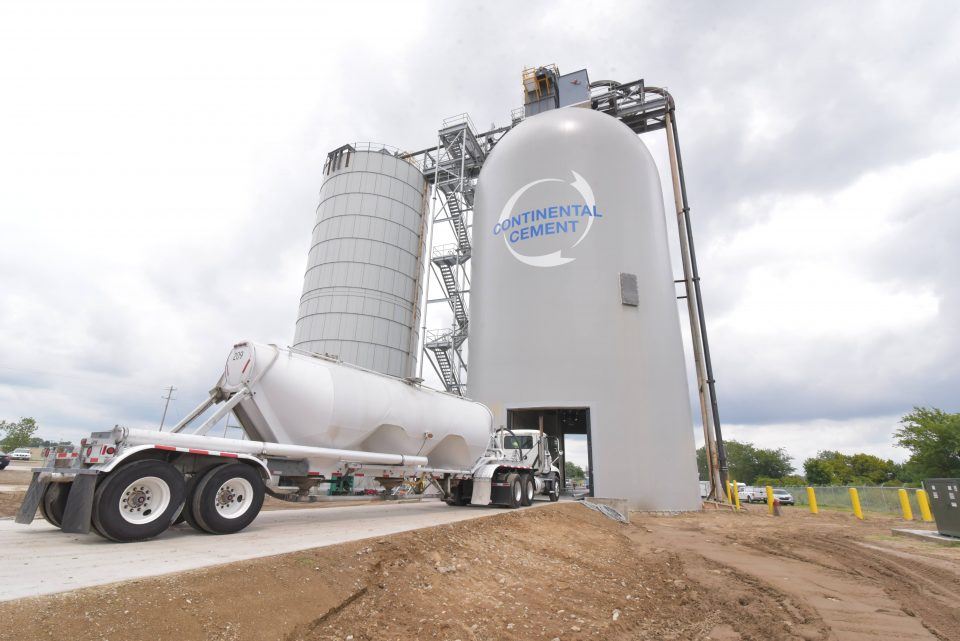Storing cement within a dome started out simply: In the 1990s cement companies wanted the dome shell and that’s about it. After decades of relying on traditional silos, dome storage was novel, and early models were basic.
“All we did was the dome storage and nothing else—the foundation and the dome. We didn’t take the opportunity or weren’t given the opportunity to say what other value we could bring,” Dome Technology vice president of operations Dan South said. Even the dome dimensions were predetermined by customers, who worked with engineers to identify the size that matched capacity needs.
To secure jobs in the early days, dome builders capitalized on price, durability, and the waterproof nature of the dome. Those selling points got the ball rolling, but as the number of cement storage domes and awareness in the industry grew, so did customer expectations.

The hemispheric dome
Early domes were hemispherical—they required a large footprint and weren’t terribly tall. This model is still used in some instances where capacity is king and land is inexpensive. The major benefits of first-generation domes were product protection and the amount of storage possible.
Front-end loading was the order of the day, but “that was inefficient and pretty unsafe,” Dome Technology sales manager Lane Roberts said. Although domes could be economically built, the reclaim left much to be desired.
Dome companies began collaborating with vendors like Cambelt, Van Aalst, Laidig, FLSmidth, and DCL to offer customers more reclaim options. Then too the shape of domes needed to change for reclaim screws and aeration options—self-unloading was clearly preferable, and an advanced reclaim system large enough to work within a large-diameter dome was cost prohibitive.

The DomeSilo
Taller domes with a smaller diameter were introduced, able to store as much as hemispheric ones and an effective complement to diverse reclaim systems. Dubbed the DomeSilo, this model is proven to be an economical and reliable solution for long-term storage.
A DomeSilo allows for more storage than a silo with a comparable footprint. Because the hemispherical geometry of a dome provides strength at all points of the structure, the entire interior can be used to contain product, right up to the apex.
A DomeSilo differs from steel tanks and silos in key ways, including upfront and long-term cost savings. This dome has a longer life cycle than a steel tank, and compared to a silo of similar dimensions, a single dome stores more product. The major DomeSilo benefits include a small footprint with generous storage, deep-foundation options ideal for port locations, product protection through climate control, pest prevention from monolithic construction, monitoring systems to maintain interior conditions, and resistance to extreme weather.
For products where explosion is a concern, round relief panels channel pressure out of the structure, preventing structural damage. Integrating a variety of reclaim systems is always an option with a DomeSilo.
Becoming a one-stop shop for dome cement storage
But as system complexity has increased, so have customer expectations.
“We found that customers wanted one place to answer as many of their questions as they could. We would see the same issues come up time and time again and finally said, ‘We can help you solve some problems,’” Dan said.
Those problems were often the result of having a host of subcontractors and vendors providing portions of the project—and sometimes the sum of the parts wasn’t as excellent as hoped.
Dome builders realized that to produce an optimal facility, they needed more sophistication. That move “was customer driven, but it was also us recognizing that every time we went in to do a project, there were 10 to 15 experts in their individual fields, but no one was really an expert over everything,” Dome Technology vice president of engineering Jason South said. “If you don’t have someone who understands those global functions, the project can be a mess.”
Dome builders in general needed to expand their knowledge and expertise. For Dome Technology, that meant developing long-term relationships with vendors of reclaim and monitoring systems; working together closely and repeatedly, storage domes and their systems functioned more seamlessly. Dome Technology also collaborated with outside engineering firms and has in-house engineers.
Dome Technology now oversees complete projects, including dome storage systems, reclaim systems, conveyance, and monitoring systems. When functioning as a one-stop shop, the resulting facility is seamless because each element is planned with the others in mind.

The Drive-Thru DomeSilo
As Dome Technology increased in sophistication and built a portfolio full of storage projects as substantial as 193,000 metric tons, the team realized they were missing out on opportunities for smaller storage.
Dome Technology developed the Drive-Thru DomeSilo to allow companies to fill truck or rail directly from the storage structure and to speed up the process of product reception to delivery.
The Drive-Thru debuted in the cement market, built for Continental Cement Co. in Memphis, Tennessee. Completed in the summer of 2018, it provides 4,500 metric tons of additional cement storage at the company’s existing site. Standing 100 feet tall and 50 feet in diameter, the Drive-Thru is situated on the river and loaded from barges. An in-line lump crusher on the loadout stack-up ensures that lumps passed through the receiving system do not make it into trucks.
Generally speaking, the Drive-Thru DomeSilo incorporates all structural, mechanical, electrical, and control systems to provide a complete turnkey solution from receiving to truck loading. “Cement companies can save on building a single drive-through storage facility by eliminating the need for multiple mechanical systems, operators and structures,” Roberts said, noting that the Drive-Thru DomeSilo complete package is less expensive to build than a silo-centric system of similar capacity.
The Drive-Thru DomeSilo incorporates a fill pipe, storage vessel, stair or ladder access, scale, and appropriate foundation. This model allows for direct load-out, where stored product flows through a spout for direct load-out into the truck or rail. The dome provides nearly 100 percent reclaim utilizing a fully aerated floor.
The system directly competes with bolted steel tanks and drive-through concrete silos. Due to unique construction techniques, this storage vessel is quickly constructed and very price competitive.
The Drive-Thru’s dimensions vary by project and customer need; the silo size can range from 1,500 to 15,000 tons and work well storing the typical drive-through capacity of 4,000 to 10,000 tons. However, by utilizing a fluidized floor system, “you could easily apply this same concept to a 60,000-ton DomeSilo,” Dome Technology CEO Bradley Bateman said. “There is no limit on the storage size for this technology.”
New customer expectations for a new era
Nowadays customers are interested in two main things with dome cement storage: schedule and risk. “Schedule is always huge, and they want it cheaper than they got it before,” Dan said. With tight margins and competition, companies need to wrap up construction quickly so cement can be loaded as soon as possible once the first shovel hits the dirt.
Risk—or avoiding it—is arguably customers’ biggest concern, Jason said. “Customers want all those individual pieces to work, and they want someone to take responsibility for that,” Jason said. The general contractor is expected to shoulder that burden.
Moving forward, the expectations for dome cement storage will continue to evolve. According to Jason, turnkey design-build projects will become more prevalent and possibly become the standard. Dan said he expects the size of storage to change. “Ten or 15 years ago, you saw a lot of really large storage. I think demand is going to be more of a micro thing, where the market will insist on smaller, more localized storage,” he said.
Speculation aside, one thing is certain: Bulk-storage companies will need to stay savvy and nimble to remain active players in the cement industry.
“Often the best innovators in the cement industry are the owners and operators of the cement plants and shipping terminals—they are living it every day. Listening to them is key, as well as finding and applying new technology that increases quality, efficiency and continued high performance of bulk-storage systems,” Dome Technology CEO Bradley Bateman said.
Editor’s note: The following article was published in the 2019 BMHR supplement of World Cement.
By Rebecca Long Pyper for Dome Technology